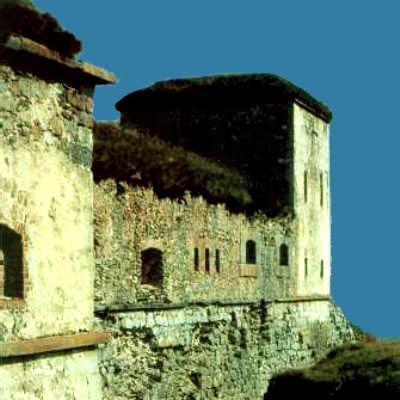From the fort protecting the harbour of Vado, a few kilometres from Savona, to the entrenched camp of Colle di Tenda, all along the Ligurian Alps there are still clear signs of the defensive system devised between 1862 and 1871 by the “Permanent Committee for the defence of the State†of the fledgling Kingdom of Italy. Seventy-seven defence works were planned to be built along the national borders; of these, between 1874 and 1880, the strongholds of Nava, San Bernardo and Melogno were built on the Ligurian front, and eight years later the “barrier of Tenda†was completed. The four fortified towns of the Maritime Alps were planned and built applying criteria which were already obsolete at the time, though some remained efficient up to the Second World War. The area of Col di Tenda, for example, was refortified in the 1940s, and, like the central fortress of Nava, was used as a barracks by Fascist militias. After the armistice of 8th September 1943, many abandoned strongholds were occupied by the partisan groups which were then being formed. The history of the “Alpine Valley†ended with the peace treaty of February 1947.
Nowadays, since the end of military secrets, the forts have become meccas for hikers and cyclists, who can enjoy to the full the network of roads originally built for purposes of war, and there is an ongoing discussion about how to convert some of the forts into tourist facilities. The Tenda District Council, for instance, has recently bought from the French army the right to use the central Fort (also known as “Colle Altoâ€), a massive building located atop a cliff in Val Roya. After the site has been cleaned up – it was also used as a munitions dump – the plan is to turn it into a military museum, followed by a hotel and restaurant. The reclamation of the fortress could be a good test of cross-border cooperation between the towns of Tenda (France) and Limone (Italy).
The artistic red brick loop-holes are a distinguishing feature of another Central fort: that of the pass of Nava, at the border between Liguria and Piedmont in the town of Pornassio (Imperia). A small Museum of the Resistance has been set up here, and the Pro Loco (Local Tourist Office) is committed to keeping it open. “We are going to try and encourage visits to the fortress next summer; the refurbishment of the whole structure is an attractive idea, but would require a huge commitment of resources. Our advice is, naturally, to explore the whole area of the stronghold of Nava, which includes another four forts and two battery emplacements, on foot or by bicycle, using the network of trails starting from the hill,†explains Piero Dani, the Chairman of the Nava Tourist Office.
There may be some chance of refurbishing the fort of Arnasco in western Liguria, an artillery emplacement disarmed during the First World War, and now handed over to the District Council. It seems far less likely that measures will be taken to restore the battery of Poggio Grande (or “fort of the Two Brothersâ€, or “fort of the Eliceta), an installation on the ridge between the valleys of Zuccarello and Balestrino.
The placements in the stronghold of Melogno, in the hinterland of Finale Ligure, are well-preserved; these comprise the Central Fort, Tortagna Fort, the battery of Bricco Merizzo and the machine-gun nests at Madonna della Neve.
While restoration of many of these military structures is little more than wishful thinking, visitors still have the chance to explore the fortresses which have remained intact by following the hiking trails (almost all marked and well-maintained) which connect them. To visit the fortified areas, and where possible to explore their interiors, which are sometimes in exactly the condition they were left in after being abandoned and, inevitably, looted, are wonderful experiences. And we wonder if these monuments are not actually more evocative in their slow, silent decay, rather than if they were turned into hotels or museums.



